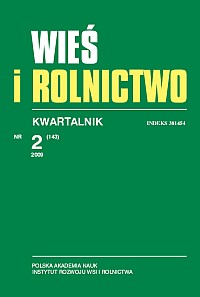Wiejskie migrowanie na przestrzeni stu lat. Studium przypadku gminy Radgoszcz
Migrations of Rural Population in the Course of a Century. The Study of the Case of Radgoszcz Commune
Author(s): Łukasz KrzyżowskiSubject(s): Social Sciences
Published by: Instytut Rozwoju Wsi i Rolnictwa Polskiej Akademii Nauk
Keywords: migrations; trans-nationality; migration traditions; village; migracje; transnarodowość; tradycje migracyjne; wieś
Summary/Abstract: The article presents the results of an analysis of migration traditions of the population of the Radgoszcz commune at the start of the 20th century and in the period following Poland's accession to the European Union within the concept of trans-nationality. The analysis has been conducted by the article's author with the purpose of establishing whether trans-national migrations, which are characterised by a large number of departures and returns, are actually a new social phenomenon. The author has chosen as the field for his exploration the Radgoszcz commune which forms a part of the Dąbrowski district in the region of Małopolska. At present the Dąbrowski district is an area characterised by a high index of international mobility (chiefly in the direction of Austria and Germany). At the start of the 20th century this district constituted the migration centre of Galicia. It should be noted, however, that a high proportion of migrants tended to return to their local communities and to repeat many times the same migration strategies. One of the proofs of strong migration traditions is the existence of two Polish community clubs in the United States, which group migrants (or the descendants of migrants) from the Radgoszcz commune. Basing on the results of field research, which covered, among other things, the examination of archival materials and the evaluation of their content, as well as a questionnaire, the author has analysed the region's migration traditions and their influence on the present international mobility of the inhabitants of the Radgoszcz commune. W artykule przedstawiono wyniki analizy tradycji migracyjnych mieszkańców gminy Radgoszcz na początku XX wieku oraz po wejściu Polski do Unii Europejskiej w ramach koncepcji transnarodowości. W tekście spróbowano odpowiedzieć na pytanie, czy migracje transnarodowe, cechujące się między innymi dużą dynamiką wyjazdów i powrotów, to rzeczywiście nowe zjawisko społeczne? Polem eksploracyjnym jest tu małopolska gmina Radgoszcz, która należy do powiatu dąbrowskiego. Jest to obecnie obszar o wysokim wskaźniku mobilności międzynarodowej (szczególnie w kierunku Austrii i Niemiec). Jednakże już na początku XX powiat dąbrowski był centrum migracyjnym w Galicji. Niemniej należy zauważyć, że duża część migrantów powracała do swoich społeczności lokalnych, jak również wielokrotnie powtarzała strategie migracyjne. Pozostałością silnych tradycji migracyjnych są między innymi dwa kluby polonijne w USA, które stowarzyszają migrantów (lub ich potomków) z gminy Radgoszcz. Na podstawie badań terenowych, obejmujących między innymi badania archiwalne, analizę treści oraz ankietę audytoryjną, przeanalizowano tradycje migracyjne regionu i ich wpływ na współczesną mobilność zagraniczną mieszkańców gminy Radgoszcz.
Journal: Wieś i Rolnictwo
- Issue Year: 143/2009
- Issue No: 2
- Page Range: 113-133
- Page Count: 21
- Language: Polish

